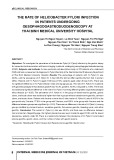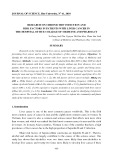
Infections in patients with cancer
-
To investigate the prevalence of Helicobacter Pylori (H. Pylori) infection by the gastric biopsy for urease test and association with lesion imaging in patients undergoing oesophagogastroduodenoscopy (OGD).
 7p
7p  viengfa
viengfa
 28-10-2024
28-10-2024
 2
2
 1
1
 Download
Download
-
Assessed the level of mRNA expression of CIZ1b, VEGF, EGFR mutations and the rate of Merkel cell infection in patients with non-small cell lung cancer. Assessed the level of mRNA expression of CIZ1b, VEGF, EGFR mutations and the rate of Merkel cell infection in patients with non-small cell lung cancer.
 32p
32p  trinhthamhodang7
trinhthamhodang7
 31-08-2020
31-08-2020
 33
33
 3
3
 Download
Download
-
Research on the risk factors of liver cancer, particularly HBV infection is necessary for preventing liver cancer and to reduce the prevalence of this cancer in future. Objectives: To identify the risk factors among patients with liver cancer in Hue college of Medicine and Pharmacy. Methods: A case-control study was conducted from May 2007 to May 2008 in which there were 40 patients with liver cancer and 40 people without any liver diseases.
 8p
8p  thiendiadaodien_9
thiendiadaodien_9
 04-03-2019
04-03-2019
 62
62
 2
2
 Download
Download
-
Lys101Glu is a drug resistance mutation in reverse transcriptase clinically observed in HIV-1 from infected patients treated with the non-nucleoside inhibitor (NNRTI) drugs nevirapine and efavirenz. In contrast to many NNRTI resistance mutations, Lys101(p66 subunit) is positioned at the sur-face of the NNRTI pocket where it interacts across the reverse transcrip-tase (RT) subunit interface with Glu138(p51 subunit).
 11p
11p  inspiron33
inspiron33
 25-03-2013
25-03-2013
 28
28
 5
5
 Download
Download
-
Other Gram-Negative Bacteria Achromobacter xylosoxidans A. xylosoxidans (previously Alcaligenes xylosoxidans) is probably part of the endogenous intestinal flora and has been isolated from water sources. Immunocompromised hosts, including patients with cancer and post- chemotherapy neutropenia, cirrhosis, and chronic renal failure, are at increased risk. Nosocomial outbreaks of A. xylosoxidans infection have been attributed to contaminated fluids, and clinical illness has been associated with isolates from many sites, including blood (often in the setting of intravascular devices).
 5p
5p  colgate_colgate
colgate_colgate
 21-12-2010
21-12-2010
 84
84
 3
3
 Download
Download
-
Clinical Features, Treatment, and Prognosis of Specific Lymphoid Malignancies Precursor Cell B Cell Neoplasms Precursor B Cell Lymphoblastic Leukemia/Lymphoma The most common cancer in childhood is B cell ALL. Although this disorder can also present as a lymphoma in either adults or children, presentation as lymphoma is rare. The malignant cells in patients with precursor B cell lymphoblastic leukemia are most commonly of pre-B cell origin.
 5p
5p  thanhongan
thanhongan
 07-12-2010
07-12-2010
 86
86
 4
4
 Download
Download
-
Granulocytosis Approximately 30% of patients with solid tumors have granulocytosis (granulocyte count 8000/µL). In about half of patients with granulocytosis and cancer, the granulocytosis has an identifiable nonparaneoplastic etiology (infection, tumor necrosis, glucocorticoid administration, etc.). The other patients have proteins in urine and serum that stimulate the growth of bone marrow cells.
 5p
5p  thanhongan
thanhongan
 07-12-2010
07-12-2010
 83
83
 4
4
 Download
Download
-
Harrison's Internal Medicine Chapter 97. Paraneoplastic Neurologic Syndromes Paraneoplastic Neurologic Syndromes: Introduction Paraneoplastic neurologic disorders (PNDs) are cancer-related syndromes that can affect any part of the nervous system (Table 97-1). They are remote effects of cancer, caused by mechanisms other than metastasis or by any of the complications of cancer such as coagulopathy, stroke, metabolic and nutritional conditions, infections, and side effects of cancer therapy. In 60% of patients the neurologic symptoms precede the cancer diagnosis.
 5p
5p  thanhongan
thanhongan
 07-12-2010
07-12-2010
 84
84
 4
4
 Download
Download
-
Diffuse interstitial infiltrates suggest viral, parasitic, or Pneumocystis pneumonia. If the patient has a diffuse interstitial pattern on chest x-ray, it may be reasonable to institute empirical treatment with TMP-SMX (for Pneumocystis) and a quinolone (for Chlamydophila, Mycoplasma, and Legionella) or an erythromycin derivative (e.g., azithromycin) while considering invasive diagnostic procedures. Noninvasive procedures, such as staining of sputum smears for Pneumocystis, serum cryptococcal antigen tests, and urine testing for Legionella antigen, may be helpful.
 5p
5p  konheokonmummim
konheokonmummim
 03-12-2010
03-12-2010
 79
79
 4
4
 Download
Download
-
Renal and Ureteral Infections Infections of the urinary tract are common among patients whose ureteral excretion is compromised (Table 82-1). Candida, which has a predilection for the kidney, can invade either from the bloodstream or in a retrograde manner (via the ureters or bladder) in immunocompromised patients. The presence of "fungus balls" or persistent candiduria suggests invasive disease. Persistent funguria (with Aspergillus as well as Candida) should prompt a search for a nidus of infection in the kidney. Certain viruses are typically seen only in immunosuppressed patients.
 7p
7p  konheokonmummim
konheokonmummim
 03-12-2010
03-12-2010
 84
84
 4
4
 Download
Download
-
Brain Masses Mass lesions of the brain most often present as headache with or without fever or neurologic abnormalities. Infections associated with mass lesions may be caused by bacteria (particularly Nocardia), fungi (particularly Cryptococcus or Aspergillus), or parasites (Toxoplasma). Epstein-Barr virus (EBV)–associated lymphoproliferative disease may also present as single or multiple mass lesions of the brain. A biopsy may be required for a definitive diagnosis. Pulmonary Infections Pneumonia (Chap.
 5p
5p  konheokonmummim
konheokonmummim
 03-12-2010
03-12-2010
 76
76
 4
4
 Download
Download
-
Typhlitis Typhlitis (also referred to as necrotizing colitis, neutropenic colitis, necrotizing enteropathy, ileocecal syndrome, and cecitis) is a clinical syndrome of fever and right-lower-quadrant tenderness in an immunosuppressed host. This syndrome is classically seen in neutropenic patients after chemotherapy with cytotoxic drugs.
 5p
5p  konheokonmummim
konheokonmummim
 03-12-2010
03-12-2010
 80
80
 5
5
 Download
Download
-
More common than tunnel infections are exit-site infections, often with erythema around the area where the line penetrates the skin. Most authorities (Chap. 129) recommend treatment (usually with vancomycin) for an exit-site infection caused by a coagulase-negative Staphylococcus. Treatment of coagulasepositive staphylococcal infection is associated with a poorer outcome, and it is advisable to remove the catheter if possible. Similarly, many clinicians remove catheters associated with infections due to P.
 5p
5p  konheokonmummim
konheokonmummim
 03-12-2010
03-12-2010
 81
81
 5
5
 Download
Download
-
Sweet's syndrome, or febrile neutrophilic dermatosis, was originally described in women with elevated white blood cell (WBC) counts. The disease is characterized by the presence of leukocytes in the lower dermis, with edema of the papillary body. Ironically, this disease now is usually seen in neutropenic patients with cancer, most often in association with acute leukemia but also in association with a variety of other malignancies. Sweet's syndrome usually presents as red or bluish-red papules or nodules that may coalesce and form sharply bordered plaques.
 6p
6p  konheokonmummim
konheokonmummim
 03-12-2010
03-12-2010
 101
101
 4
4
 Download
Download
-
Figure 82-1 A. Papules related to Escherichia coli bacteremia in a neutropenic patient with acute lymphocytic leukemia. B. The same lesion the following day. Candidemia (Chap. 196) is also associated with a variety of skin conditions and commonly presents as a maculopapular rash. Punch biopsy of the skin may be the best method for diagnosis. Cellulitis, an acute spreading inflammation of the skin, is most often caused by infection with group A Streptococcus or Staphylococcus aureus, virulent organisms normally found on the skin (Chap. 119).
 5p
5p  konheokonmummim
konheokonmummim
 03-12-2010
03-12-2010
 81
81
 4
4
 Download
Download
-
The level of suspicion of infections with certain organisms should depend on the type of cancer diagnosed (Table 82-3). Diagnosis of multiple myeloma or CLL should alert the clinician to the possibility of hypogammaglobulinemia. While immunoglobulin replacement therapy can be effective, in most cases prophylactic antibiotics are a cheaper, more convenient method of eliminating bacterial infections in CLL patients with hypogammaglobulinemia.
 5p
5p  konheokonmummim
konheokonmummim
 03-12-2010
03-12-2010
 80
80
 5
5
 Download
Download
-
A similar problem can affect patients whose lymph node integrity has been disrupted by radical surgery, particularly patients who have had radical node dissections. A common clinical problem following radical mastectomy is the development of cellulitis (usually caused by streptococci or staphylococci) because of lymphedema and/or inadequate lymph drainage. In most cases, this problem can be addressed by local measures designed to prevent fluid accumulation and breaks in the skin, but antibiotic prophylaxis has been necessary in refractory cases.
 6p
6p  konheokonmummim
konheokonmummim
 03-12-2010
03-12-2010
 66
66
 4
4
 Download
Download
-
Harrison's Internal Medicine Chapter 82. Infections in Patients with Cancer Infections in Patients with Cancer: Introduction Infections are a common cause of death and an even more common cause of morbidity in patients with a wide variety of neoplasms. Autopsy studies show that most deaths from acute leukemia and half of deaths from lymphoma are caused directly by infection. With more intensive chemotherapy, patients with solid tumors have also become more likely to die of infection.
 6p
6p  konheokonmummim
konheokonmummim
 03-12-2010
03-12-2010
 89
89
 8
8
 Download
Download
-
Death and Dying The most common causes of death in patients with cancer are infection (leading to circulatory failure), respiratory failure, hepatic failure, and renal failure. Intestinal blockage may lead to inanition and starvation. Central nervous system disease may lead to seizures, coma, and central hypoventilation. About 70% of patients develop dyspnea preterminally. However, many months usually pass between the diagnosis of cancer and the occurrence of these complications, and during this period the patient is severely affected by the possibility of death. ...
 5p
5p  konheokonmummim
konheokonmummim
 03-12-2010
03-12-2010
 97
97
 6
6
 Download
Download
CHỦ ĐỀ BẠN MUỐN TÌM































